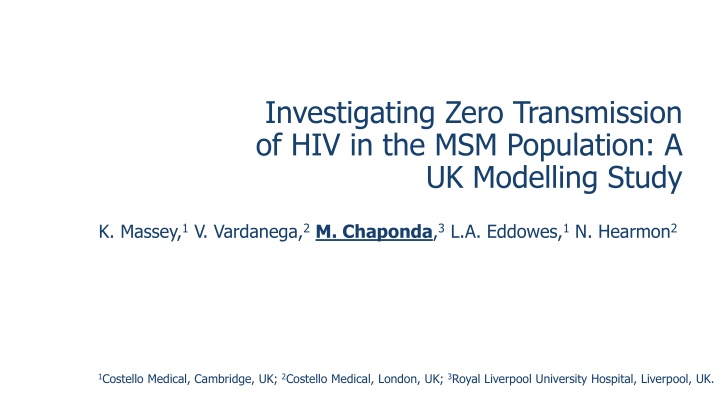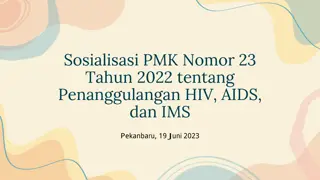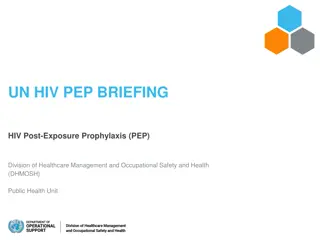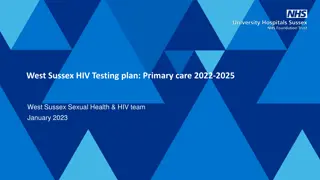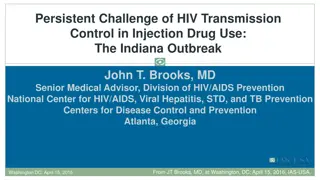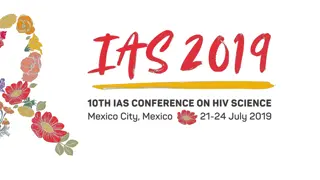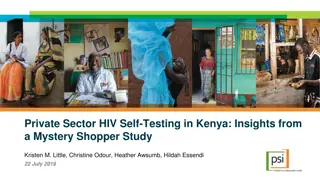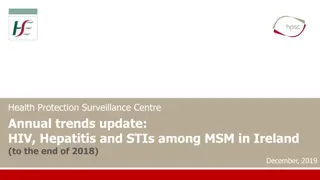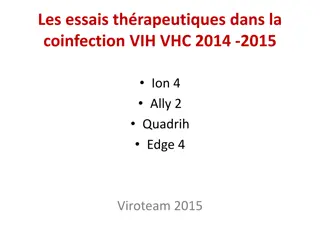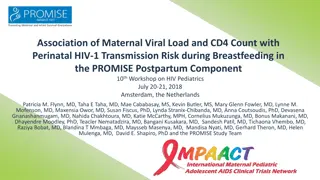Investigating Zero Transmission of HIV in MSM Population: A UK Modelling Study
Investigating the feasibility of achieving zero transmission of HIV in the MSM population in the UK by 2030 based on current trends and model outcomes. The study evaluates key parameters, model methodology, and sets of results to determine the challenges in reaching this ambitious goal. Factors such as incidence reduction, PrEP uptake, diagnosis rates, treatment initiation, and viral suppression are analyzed to provide insights into the pathway to zero transmission.
Download Presentation

Please find below an Image/Link to download the presentation.
The content on the website is provided AS IS for your information and personal use only. It may not be sold, licensed, or shared on other websites without obtaining consent from the author.If you encounter any issues during the download, it is possible that the publisher has removed the file from their server.
You are allowed to download the files provided on this website for personal or commercial use, subject to the condition that they are used lawfully. All files are the property of their respective owners.
The content on the website is provided AS IS for your information and personal use only. It may not be sold, licensed, or shared on other websites without obtaining consent from the author.
E N D
Presentation Transcript
Investigating Zero Transmission of HIV in the MSM Population: A UK Modelling Study K. Massey,1V. Vardanega,2M. Chaponda,3L.A. Eddowes,1N. Hearmon2 1Costello Medical, Cambridge, UK; 2Costello Medical, London, UK; 3Royal Liverpool University Hospital, Liverpool, UK.
Presenter disclosure information Mas Chaponda has received educational grants from AbbVie, Gilead, Merck, Sharpe and Dohme and ViiV Katherine Massey, Vittoria Vardanega, Lucy A. Eddowes and Natalie Hearmon are employees of Costello Medical Consulting Ltd., which was funded by Gilead to conduct this study Model development was funded by Gilead. Gilead contributed to model design, specification and final draft and participated in data analysis and interpretation. Gilead participated in the writing, review and approval of this presentation
Targeting zero transmission The UK has met the UNAIDS 90-90-90 goals and has now targeted zero transmission of HIV by 2030; how can this ambitious goal be reached? 94% of people living with HIV (PLWH; 98,600) are aware of their status 98% of PLWH (96,866) are aware of their HIV status are on HIV treatment 97% of PLWH (93,960) on HIV treatment are virologically suppressed UK 90-90-90 Status (2019 data) Source: Public Health England 2020. Available at https://assets.publishing.service.gov.uk/government/uploads/system/uploads/attachment_data/file/939478/hpr2020_hiv19.pdf
Model methodology Key model characteristics State transition Markov model Model design Zero transmission definition Key parameters 60% incidence reduction compared with 2010 incidence Rate of pre-exposure prophylaxis (PrEP) uptake Proportion of PLWH diagnosed within 3 months of infection Annual probability of having a HIV test Probability of starting treatment within 6 months of diagnosis Probability of starting treatment within 3 months of diagnosis Proportion of patients on antiretroviral therapy (ART) who are virologically suppressed
Results: Given the current trajectory of the HIV epidemic, zero transmission will not be reached in UK MSM by 2030
Results: Individual changes to key screening, treatment or prevention parameters are not a realistic route to zero Making individual changes to key screening, treatment or prevention parameters individually allows zero transmission to be reached by 2030 in some cases, however, unrealistic increases in these parameters are required Input value required (2020 value) 9.08% (0.08%) Zero transmission year 2030 Parameter Rate of PrEP uptake Annual probability of having a HIV test Probability of starting treatment within three months of HIV diagnosis 96.85% (22.35%) 2030 100% (78%) 2032
Results: A combination approach to screening, treatment and prevention is needed to achieve zero by 2030 (1) Parameter Rate of PrEP uptake Proportion of PLWH diagnosed within 3 months of infection Annual probability of having a HIV test Probability of starting treatment within 6 months of diagnosis Probability of starting treatment within three months of HIV diagnosis Proportion of patients on ART who are virologically suppressed Input value (2020 value) 0.25% (0.08%) 40% (26%) 40% (22.35%) 98% (95.17%) 90% (78%) 99% (97%)
Results: A combination approach to screening, treatment and prevention is needed to achieve zero by 2030 (2) Zero transmission can be reached in UK MSM by 2030 using a combination approach to screening, treatment and prevention, increasing all six key parameters to achievable levels
Conclusions A combination approach, increasing HIV screening, treatment and prevention parameters, is the most feasible way for the UK to reach its goal of zero HIV transmission by 2030 Study design and results align with other HIV modelling studies and with the independent UK HIV Commission targets and recommendations The impact of COVID-19 on HIV transmission in the UK was not taken into account as the impact is not yet known; policy changes aimed at reaching zero transmission will need to account for the impact of COVID-19
